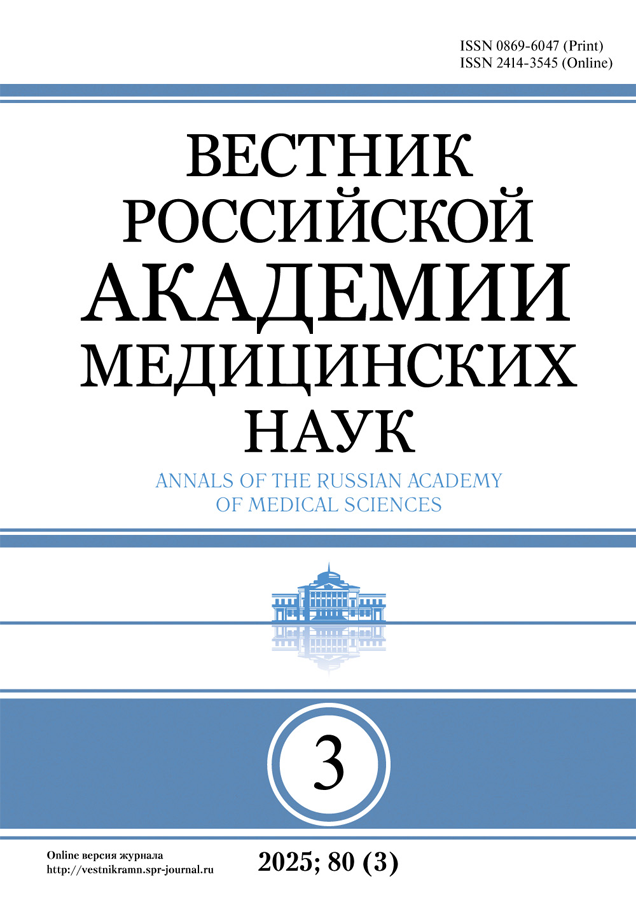Субпопуляции регуляторных Т-лимфоцитов в периферической крови больных ревматоидным артритом
- Авторы: Кравченко П.Н.1, Жулай Г.А.1, Чуров А.В.1, Олейник Е.К.1, Олейник В.М.1, Барышева О.Ю.2, Везикова Н.Н.2, Марусенко И.М.2
-
Учреждения:
- Институт биологии Карельского научного центра РАН, Петрозаводск
- Петрозаводский государственный университет, Петрозаводск
- Выпуск: Том 71, № 2 (2016)
- Страницы: 148-153
- Раздел: АКТУАЛЬНЫЕ ВОПРОСЫ РЕВМАТОЛОГИИ
- Дата публикации: 05.04.2016
- URL: https://vestnikramn.spr-journal.ru/jour/article/view/656
- DOI: https://doi.org/10.15690/vramn656
- ID: 656
Цитировать
Полный текст
Аннотация
Обоснование: Ревматоидный артрит (РА) представляет собой воспалительное ревматическое заболевание, связанное с нарушением Т-клеточной толерантности в организме, приводящее к инвалидизации трудоспособного населения. Важную роль в регуляции аутоиммунных реакций играют регуляторные CD4+ Т-лимфоциты (Тreg), которые обеспечивают супрессию иммунных реакций. Вместе с тем нет единого мнения о содержании этих клеток и их роли в патогенезе РА.
Цель исследования: Оценить количество регуляторных Т-клеток (Treg) периферической крови больных РА по экспрессии молекул CD4, CD25, CD127, FOXP3, а также уровень экспрессии двух функциональных молекул (CTLA-4 и CCR4) Treg-клетками больных РА.
Методы: Исследовали образцы периферической крови больных РА (в возрасте 61,1±10,5 лет) и здоровых доноров (в возрасте 52,2±14,0 лет). Содержание клеток и экспрессию молекул оценивали методом проточной цитометрии.
Результаты: Изучены образцы крови 36 больных РА и 20 здоровых доноров. Количество клеток с Treg-ассоциированными фенотипами CD4+CD25hi и CD4+CD25hiCD127low/– у больных РА было выше по сравнению со здоровыми донорами (p<0,05). Также у больных РА отмечено повышенное число CD4+ Т-клеток, экспрессирующих FOXP3 (p<0,01), что может быть связано c увеличением популяции CD4+FOXP3+CD25– лимфоцитов (p<0,05), тогда как содержание CD4+ FOXP3+CD25+ Treg-клеток при РА было на уровне контроля. Экспрессия функциональной молекулы-костимулятора CTLA-4 Treg-клетками больных РА не отличалась от контроля, в то время как уровень экспрессии хемокинового рецептора CCR4, обеспечивающего миграцию лимфоцитов в места воспаления и барьерные ткани, значительно возрастал у больных РА (p<0,01).
Заключение: В периферической крови больных РА отмечено увеличение некоторых популяций клеток, ассоциированных с активностью Treg-лимфоцитов. Изменение уровня экспрессии хемокинового рецептора CCR4 при РА позволяет предположить значительное усиление миграции лимфоцитов с периферии в синовиальную жидкость сустава.
Об авторах
Полина Николаевна Кравченко
Институт биологии Карельского научного центра РАН, Петрозаводск
Автор, ответственный за переписку.
Email: k-polina13@mail.ru
Mладший научный сотрудник группы иммунологии.
Адрес: 185910, Республика Карелия, Петрозаводск, ул. Пушкинcкая, д. 11
РоссияГалина Анатольевна Жулай
Институт биологии Карельского научного центра РАН, Петрозаводск
Email: zhgali-111@rambler.ru
Младший научный сотрудник группы иммунологии.
Адрес: 185910, Республика Карелия, Петрозаводск, ул. Пушкинcкая, д. 11
РоссияАлексей Викторович Чуров
Институт биологии Карельского научного центра РАН, Петрозаводск
Email: achurou@yandex.ru
Кандидат биологических наук, научный сотрудник группы иммунологии.
Адрес: 185910, Республика Карелия, Петрозаводск, ул. Пушкинcкая, д. 11
РоссияЕвгения Константиновна Олейник
Институт биологии Карельского научного центра РАН, Петрозаводск
Email: ole@krc.karelia.ru
Доктор биологических наук, доцент, главный научный сотрудник, руководитель группы иммунологии.
Адрес: 185910, Республика Карелия, Петрозаводск, ул. Пушкинcкая, д. 11
РоссияВиктор Михайлович Олейник
Институт биологии Карельского научного центра РАН, Петрозаводск
Email: scigraph@yandex.ru
Доктор биологических наук, ведущий научный сотрудник группы иммунологии.
Адрес: 185910, Республика Карелия, Петрозаводск, ул. Пушкинcкая, д. 11
РоссияОльга Юрьевна Барышева
Петрозаводский государственный университет, Петрозаводск
Email: olgar@karelia.ru
Доктор медицинских наук, доцент, профессор кафедры госпитальной терапии медицинского института.
Адрес: 185910, Республика Карелия, Петрозаводск, пр. Ленина, д. 33
РоссияНаталья Николаевна Везикова
Петрозаводский государственный университет, Петрозаводск
Email: vezikov23@mail.ru
Доктор медицинских наук, профессор, заведующая кафедрой госпитальной терапии медицинского института.
Адрес: 185910, Республика Карелия, Петрозаводск, пр. Ленина, д. 33
РоссияИрина Михайловна Марусенко
Петрозаводский государственный университет, Петрозаводск
Email: feva@karelia.ru
Доктор медицинских наук, профессор кафедры госпитальной терапии медицинского института.
Адрес: 185910, Республика Карелия, Петрозаводск, пр. Ленина, д. 33
РоссияСписок литературы
- Buckner JH. Mechanisms of impaired regulation by CD4(+) CD25(+)FOXP3(+) regulatory T cells in human autoimmune diseases. Nat Rev Immunol. 2010;10(12):849–859. doi: 10.1038/nri2889.
- Sakaguchi S, Miyara M, Costantino CM, Hafler DA. FOXP3+ regulatory T cells in the human immune system. Nat Rev Immunol. 2010;10(7):490–500. doi: 10.1038/nri2785.
- Seddiki N, Santner-Nanan B, Martinson J, et al. Expression of interleukin (IL)-2 and IL-7 receptors discriminates between human regulatory and activated T cells. J Exp Med. 2006;203(7):1693– 1700. doi: 10.1084/jem.20060468.
- Shevach EM. Mechanisms of foxp3+ T regulatory cell-mediated suppression. Immunity. 2009;30(5):636–645. doi: 10.1016/j.immuni.2009.04.010.
- Han GM, O’Neil-Andersen NJ, Zurier RB, Lawrence DA. CD4+CD25high T cell numbers are enriched in the peripheral blood of patients with rheumatoid arthritis. Cell Immunol. 2008;253(1-2):92–101. doi: 10.1016/j.cellimm.2008.05.007.
- Kawashiri S-Y, Kawakami A, Okada A, et al. CD4+CD25highCD127low/-Treg cell frequency from peripheral blood correlates with disease activity in patients with rheumatoid arthritis. J Rheumatol. 2011;38(12):2517–2521. doi: 10.3899/jrheum.110283.
- Kim JR, Chae JN, Kim SH, Ha JS. Subpopulations of regulatory T cells in rheumatoid arthritis, systemic lupus erythematosus, and Behcet’s disease. J Korean Med Sci. 2012;27(9):1009–1013. doi: 10.3346/jkms.2012.27.9.1009.
- Kosmaczewka A, Ciszak L, Swierkot J, et al. Alterations in Both the Activatory and Inhibitory Potential of Peripheral Blood CD4+ T Cells in Rheumatoid Arthritis Patients Correlate with Disease Progression. Pathol Oncol Res. 2014;20(2):235–243. doi: 10.1007/s12253-013-9687-0.
- Moradi B, Schnatzer P, Hagmann S, et al. CD4+CD25+/ highCD127low/regulatory T cells are enriched in rheumatoid arthritis and osteoarthritis joints — analysis of frequency and phenotype in synovial membrane, synovial fluid and peripheral blood. Arthritis Res Ther. 2014;16(2):R97. doi: 10.1186/ar4545.
- Campbell DJ, Koch MA. Phenotypical and functional specialization of FOXP3+ regulatory T cells. Nat Rev Immunol. 2011;11(2):119–130. doi: 10.1038/nri2916.
- Alvarez-Quiroga C, Abud-Mendoza C, Doniz-Padilla L, et al. CTLA-4-Ig therapy diminishes the frequency but enhances the function of Treg cells in patients with rheumatoid arthritis. J Clin Immunol. 2011;31(4):588–595. doi: 10.1007/s10875-011-9527-5.
- Flores-Borja F, Jury EC, Mauri C, Ehrenstein MR. Defects in CTLA-4 are associated with abnormal regulatory T cell function in rheumatoid arthritis. Proc Natl Acad Sci U S A. 2008;105(49):19396–19401. doi: 10.1073/pnas.0806855105.
- Aerts NE, Dombrecht EJ, Ebo DG, et al. Activated T cells complicate the identification of regulatory T cells in rheumatoid arthritis. Cell Immunol. 2008;251(2):109-115. doi: 10.1016/j.cellimm.2008.04.008.
- Miyara M, Yoshioka Y, Kitoh A, et al. Functional delineation and differentiation dynamics of human CD4+ T cells expressing the FoxP3 transcription factor. Immunity. 2009;30(6):899–911. doi: 10.1016/j.immuni.2009.03.019.
- Jiao Z, Wang W, Jia R, et al. Accumulation of FoxP3-expressing CD4+CD25+ T cells with distinct chemokine receptors in synovial fluid of patients with active rheumatoid arthritis. Scand J Rheumatol. 2007;36(6):428–433. doi: 10.1080/03009740701482800.
Дополнительные файлы








